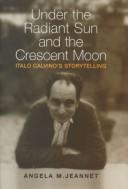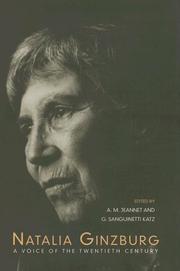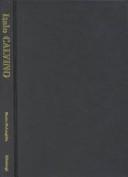| Listing 1 - 10 of 47 | << page >> |
Sort by
|
Book
ISBN: 1442699515 9781442699519 9781442644267 1442644265 1442699523 Year: 2012 Publisher: Toronto
Abstract | Keywords | Export | Availability | Bookmark
 Loading...
Loading...Choose an application
- Reference Manager
- EndNote
- RefWorks (Direct export to RefWorks)
Immensely entertaining and readable, The Pleasant Nights will appeal to anyone interested in fairy tales, ancient stories, and folk creations.
Book

ISBN: 3110640066 3110640058 Year: 2020 Publisher: De Gruyter
Abstract | Keywords | Export | Availability | Bookmark
 Loading...
Loading...Choose an application
- Reference Manager
- EndNote
- RefWorks (Direct export to RefWorks)
I saggi raccolti in questo volume affrontano il complesso e dinamico rapporto tra l’identità e il confine in autori che appartengono a territori che, in seguito alla dissoluzione dell’Impero asburgico e alla seconda guerra mondiale, sono distribuiti tra Italia, Austria, Slovenia, Croazia e le regioni limitrofe. In questo contesto l’identità deve essere intesa essenzialmente come espressione di lingua, cultura e tradizioni, ossia di una memoria e un’esperienza individuale che si radicano in una memoria e in un’esperienza collettiva. Il confine – che per effetto di vicende storiche viene a spostarsi nello spazio – deve essere indagato, a sua volta, in ottica geostorica oltreché in funzione costruttiva dell’identità. Tuttavia vi è anche un altro confine, quello tra lingue, culture e tradizioni diverse, che attraversa un medesimo territorio. Ecco quindi le identità stratificate, composite, fluide, ma anche conculcate e costrette a ridefinirsi, nella difficoltà ma anche nella necessità del dialogo, nella ricerca di valori condivisi, di ciò che unisce piuttosto di ciò che divide, in quella vocazione alla pluralità che potrebbe e dovrebbe costituire e definire l’identità europea. Ed è questo un compito che vogliono e sembrano efficacemente assumersi la letteratura e il cinema intesi nella loro varietà e specificità. The studies gathered in this volume analyze, in authors from Italy, Austria, Slovenia, Croatia, and neighboring territories, the complex relation between identity and borders, namely those between languages and cultures, that can cut through one single territory. We are looking at identities made of different layers and elements, blurred and oppressed, and constantly forced to redefine themselves, in dialog with one another.
LITERARY CRITICISM / European / Italian. --- Borders. --- Cultural Identity.

ISBN: 1282042211 9786612042218 1442682868 9781442682863 9781282042216 0802047246 9780802047243 Year: 2000 Publisher: Toronto, Ont. University of Toronto Press
Abstract | Keywords | Export | Availability | Bookmark
 Loading...
Loading...Choose an application
- Reference Manager
- EndNote
- RefWorks (Direct export to RefWorks)
Although Italo Calvino (1923-1985) is one of the most widely read and translated Italian novelists of the century, a comprehensive analytical work in English of his writings has been unavailable until now. In this new study Angela Jeannet offers a rich and vibrant critical portrait that integrates Calvino the creative writer with Calvino the critical thinker, two roles that the novelist himself saw as intimately connected. "Under the Radiant Sun and the Crescent Moon" examines the cultural and literary matrix of Calvino's complex fictional universe, focusing on his passion for storytelling and the various stages in the evolution of his work. Calvino lived in a culture undergoing profound transformations. Jeannet traces the important creative influences and events in his life and their significance for his writing, from his cultivated bourgeois upbringing and reading of the Modernists to his confrontation with post-war industrialism, the consumer culture of the 1960s, and beyond. Throughout the study Jeannet brings to light Calvino's views on the function of storytelling in literature and society and his strong connections to the Italian poetic tradition. She also explores aspects of Calvino's work that deserve more attention, including the critically neglected Marcovaldo stories and the metaphorical role of the feminine in his fictional world.
LITERARY CRITICISM / European / Italian. --- Calvino, Italo --- Criticism and interpretation. --- storytelling

ISBN: 1282042203 9786612042201 1442677570 9781442677579 9781282042209 080204722X 9780802047229 9781487586799 1487586795 9781487587277 1487587279 Year: 2000 Publisher: Toronto
Abstract | Keywords | Export | Availability | Bookmark
 Loading...
Loading...Choose an application
- Reference Manager
- EndNote
- RefWorks (Direct export to RefWorks)
A prominent and prolific Italian writer, Natalia Ginzburg (1916-1991) is known for her novels, plays, short stories, and essays. This collection brings together, for an English-speaking audience, a variety of critical perspectives on Ginzburg's work. The essays, all by North American scholars, examine the author's entire production. The topics examined include Ginzburg's struggle to define herself as a woman, a writer, and an intellectual; her interpretation of the relationship between historical events and private lives; her reflections on the women's movement and the changing nature of the family; and her mastery of a distinctly personal writing style. What emerges here is a nuanced and complex portrait of Ginzburg and her work. The reader is given a sense of the importance of her contribution, not only as a writer but as a witness to the events of the twentieth century. The volume also includes a chronology, a bibliography, and translations of some of Ginzburg's lesser-known writings, including three articles, a poem, and a one-act play.
Book
ISBN: 0691643091 1400853427 0691615713 9781400853427 9780691615714 0691064245 9780691064246 9780691615714 Year: 2014 Publisher: Princeton, NJ
Abstract | Keywords | Export | Availability | Bookmark
 Loading...
Loading...Choose an application
- Reference Manager
- EndNote
- RefWorks (Direct export to RefWorks)
Contemporary with the Romantic generation, peer of Keats, Holderlin, and Goethe, and forerunner of Valéry and Pound, Ugo Foscolo is nevertheless little known outside Italy. In an endeavor to "discover" this exemplary European poet for English-speaking readers, and to "rediscover" him for Italian readers, Glauco Cambon examines both textually and contextually Foscolo's major works and their inextricable connection with his life, his philosophy, and his aesthetic principles.Originally published in 1980.The Princeton Legacy Library uses the latest print-on-demand technology to again make available previously out-of-print books from the distinguished backlist of Princeton University Press. These editions preserve the original texts of these important books while presenting them in durable paperback and hardcover editions. The goal of the Princeton Legacy Library is to vastly increase access to the rich scholarly heritage found in the thousands of books published by Princeton University Press since its founding in 1905.
Book
ISBN: 1442617535 9781442617537 1442648716 9781442648715 1442617543 Year: 2014 Publisher: Toronto
Abstract | Keywords | Export | Availability | Bookmark
 Loading...
Loading...Choose an application
- Reference Manager
- EndNote
- RefWorks (Direct export to RefWorks)
An insightful history of book reviewing as a genre and a detailed study of its role in Italian literary culture, Reviewing Mario Pratesi opens up a new area for investigation within Italian literary studies.
Book
ISBN: 3110701863 3110701502 Year: 2022 Publisher: Berlin ; Boston : De Gruyter,
Abstract | Keywords | Export | Availability | Bookmark
 Loading...
Loading...Choose an application
- Reference Manager
- EndNote
- RefWorks (Direct export to RefWorks)
Il presente volume intende indagare la tematica dell’ars dictaminis secondo un approccio di impianto codicologico e paleografico, ovvero attraverso lo studio primario delle testimonianze manoscritte che si prefigge di condurre ad una migliore contestualizzazione storica del fenomeno, e di analizzare le strette interrelazioni esistenti tra l’ars dictaminis e il sistema politico e sociale dell’epoca. Apre il volume una introduzione di carattere generale sullo scopo e sulla metodologia adoperata nella ricerca, e sull’importanza di una impostazione codicologica alla questione. Nei due capitoli successivi si individueranno gli aspetti caratterizzanti la produzione e la circolazione manoscritta dettatoria riguardante, rispettivamente, i secoli XIII e XIV, e il periodo umanistico. Segue un quarto capitolo dove si illustreranno, in un’ottica comparativa, le peculiarità della tradizione manoscritta di autori e testi in rapporto con le opere del retore bolognese, come la Brevis introductio ad dictamen di Giovanni di Bonandrea, i trattati morali di Albertano da Brescia e la Piccola dottrina del parlare e del tacere. Concluderanno il volume tavole sinottiche finalizzate a rendere facilmente consultabile l’elenco dei testimoni analizzati. This volume is dedicated to the study of medieval ars dictaminis. Analyzing several manuscript witnesses, it sheds light on the historical contextualization of the phenomenon and examines the close relationship between ars dictaminis and the political and social system of that time.
LITERARY CRITICISM / European / Italian. --- Ars dictaminis. --- Medieval Literature.
Book

ISBN: 9783111167169 Year: 2023 Publisher: Berlin ; Boston : De Gruyter,
Abstract | Keywords | Export | Availability | Bookmark
 Loading...
Loading...Choose an application
- Reference Manager
- EndNote
- RefWorks (Direct export to RefWorks)
Italian literature emerged around 1600 at the intersection of poetological and religious attempts at standardization and under the attentive watch of a literary community and its critical discussions as well as the censorship and inquisition of the Counter-Reformation. This volume sheds light on creativity under the conditions of this twofold "observance" by looking at texts from various genres written between ca. 1550 and 1650. Italienische Literatur entsteht um 1600 in einem Schnittpunkt von poetologischen und religiösen Normierungsbestrebungen und unter wachsamer Beobachtung sowohl seitens einer kritisch diskutierenden literarischen Gemeinschaft als auch der gegenreformatorischen Zensur und Inquisition. Kirchliche Autoritäten kontrollieren die Literatur von außen, während die Literaten in einem Dialog des Aushandelns von Normen und der wachsamen Beratung und Kritik untereinander begriffen sind. Der Titel dieses Bandes benennt dies mit dem Begriff der ‚Observanz‘ in seiner Doppelbedeutung von ‚Beobachtung’ und ‚Regelbeachtung‘. Diese Situation nur als äußere Beschränkung künstlerischen Schaffens zu fassen, wäre freilich reduktiv. Anhand von Texten unterschiedlicher medialer und gattungspoetischer Formate vom Epos bis zur Oper wird gezeigt, wie zwischen 1550 und 1650 dichterische Kreativität unter den besonderen Bedingungen dieser doppelten Observanz zu Lösungen, Evasionen oder Immunisierungen gelangt; wie Autoren auf die textuelle und mediale Gestalt ihrer Werke und auf die Gestaltung oder auch Verhüllung ihrer Autorschaft achtgeben und wie andererseits die Aufmerksamkeit der Rezipierenden auf Problemlagen fokussiert oder aber zerstreut werden kann.
LITERARY CRITICISM / European / Italian. --- Aristotelianism. --- Censorship. --- Counter-Reformation. --- opera libretto.
Book

ISBN: 3111166651 311116716X Year: 2023 Publisher: Berlin ; Boston : De Gruyter,
Abstract | Keywords | Export | Availability | Bookmark
 Loading...
Loading...Choose an application
- Reference Manager
- EndNote
- RefWorks (Direct export to RefWorks)
Italian literature emerged around 1600 at the intersection of poetological and religious attempts at standardization and under the attentive watch of a literary community and its critical discussions as well as the censorship and inquisition of the Counter-Reformation. This volume sheds light on creativity under the conditions of this twofold "observance" by looking at texts from various genres written between ca. 1550 and 1650. Italienische Literatur entsteht um 1600 in einem Schnittpunkt von poetologischen und religiösen Normierungsbestrebungen und unter wachsamer Beobachtung sowohl seitens einer kritisch diskutierenden literarischen Gemeinschaft als auch der gegenreformatorischen Zensur und Inquisition. Kirchliche Autoritäten kontrollieren die Literatur von außen, während die Literaten in einem Dialog des Aushandelns von Normen und der wachsamen Beratung und Kritik untereinander begriffen sind. Der Titel dieses Bandes benennt dies mit dem Begriff der ‚Observanz‘ in seiner Doppelbedeutung von ‚Beobachtung’ und ‚Regelbeachtung‘. Diese Situation nur als äußere Beschränkung künstlerischen Schaffens zu fassen, wäre freilich reduktiv. Anhand von Texten unterschiedlicher medialer und gattungspoetischer Formate vom Epos bis zur Oper wird gezeigt, wie zwischen 1550 und 1650 dichterische Kreativität unter den besonderen Bedingungen dieser doppelten Observanz zu Lösungen, Evasionen oder Immunisierungen gelangt; wie Autoren auf die textuelle und mediale Gestalt ihrer Werke und auf die Gestaltung oder auch Verhüllung ihrer Autorschaft achtgeben und wie andererseits die Aufmerksamkeit der Rezipierenden auf Problemlagen fokussiert oder aber zerstreut werden kann.
LITERARY CRITICISM / European / Italian. --- Aristotelianism. --- Censorship. --- Counter-Reformation. --- opera libretto.

ISBN: 0748609172 0748607358 1474470904 Year: 1998 Volume: *4 Publisher: Edinburg : Edinburgh University Press,
Abstract | Keywords | Export | Availability | Bookmark
 Loading...
Loading...Choose an application
- Reference Manager
- EndNote
- RefWorks (Direct export to RefWorks)
This first study in English of the complete writings of Italo Calvino (1923-85) offers new interpretations of Calvino's main works, taking into account some important unpublished material, and analyses Calvino's intertextual links with major writers of world literature (Conrad, Stevenson, Hemingway and Borges). Postmodern elements in his texts are assessed, and a chapter on Calvino's critical essays shed important light on his creative process.
| Listing 1 - 10 of 47 | << page >> |
Sort by
|

 Search
Search Feedback
Feedback About UniCat
About UniCat  Help
Help News
News